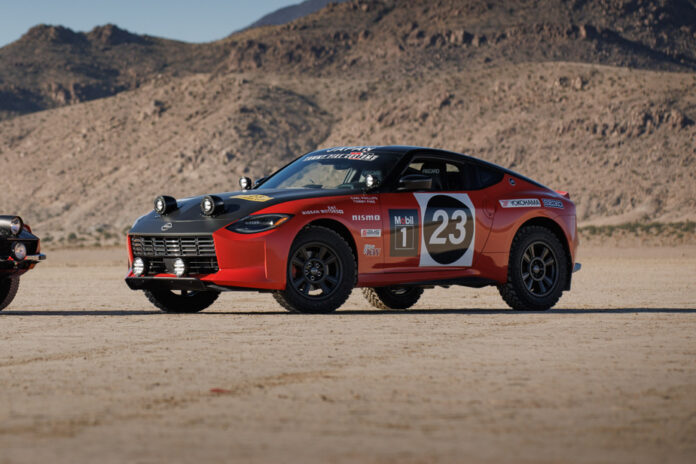For automotive industry equipment manufacturers, the SEMA show in Las Vegas has established itself over the years as an essential event for exhibiting their know-how. Held since 1963 without access to the public, it is also the scene of the most unabashed extravagances. If the last edition left room for electrification, that of 2023 brings forward mechanical combustion engines. Here are some curiosities.
Nissan indulged in some nostalgia at this year’s SEMA show by displaying a Nissan Z that pays homage to a Dastun 240Z that won the 1971 Safari Rally, a grueling 6,000-plus-mile event held in Kenya. For the occasion, this Z has seen its suspension elements completely revised and is raised by 5 cm. The chassis gets skid plates and the 17” rims don Yokohama GEOLANDAR M/T off-road tires. Its 3.0L twin-turbo V6 is also slightly tweaked.
Toyota, for its part, presented a deeply modified Tacoma at SEMA which nods to the era of sporty pickup trucks from the 1990s and 2000s. Featuring the mechanics of a Tundra, a reworked 3.4L twin-turbo V6 to produce 421 hp, this Tacoma X-Runner has widened tracks and a stiffened platform to support its rather… extravagant design. The suspensions have been redesigned by adding the Tundra’s pneumatic system to correct the level when the pickup truck is towing a trailer.
The Korean manufacturer Hyundai, for its part, unveiled a stylistic exercise at SEMA 2023 with a Kona Jayde Concept equipped for “urban adventures”. Some of its body parts have been retouched and embellished with a fairly eye-catching turquoise. Eibach springs lower the ground clearance and Recaro seats are fixed in the cabin for a sportier presentation. A matching electric bike completes the whole thing with a Thule box on the roof.
Very well known in the world of “resto-mod”, this subcategory of tuning which mixes restoration and aesthetic and mechanical modifications, the Ringbrothers exhibited a Rolls-Royce pumped up on steroids. Under its aristocratic bodywork, this 1961 Silver Cloud II hides an extraordinary force: a 6.2L LT4 V8 of General Motors origin supercharged by a compressor of 640 hp, more than two and a half times the power of the time . Unsurprisingly, the chassis is entirely new to negotiate with this extra power.
The head of General Motors, Mary Barra, recently confirmed during a conference call with her shareholders that the battery of the next Chevrolet Bolt will be composed of lithium-iron-phosphate (LFP) cells.
This type of battery, also used by Ford and Tesla among others, is significantly less expensive to produce than the commonly used nickel-manganese-cobalt batteries due to the fact that it does not use cobalt or nickel in its manufacture. It is also more durable by tolerating a greater number of cycles and recharge power before showing signs of deterioration. On the other hand, these batteries perform less well in cold weather and can store less energy, Ford said last February when announcing their use in the Mustang Mach-E and the F-150 Lightning.
Barra specified that this shift towards an LFP battery will shorten the development period by two years while ensuring savings “billions of dollars”. The cost of assembling each copy will also be “significantly lower”, she also stressed. In 2016, Bloomberg revealed that GM expected to lose between US$8,000 and US$9,000 per assembled Chevrolet Bolt.
The CEO of GM also said that this new Bolt will allow “a better driving, charging and use experience”. This seems promising, if the starting price is obviously competitive.
The month of October saw a series of major recalls to correct various defects. Here are some which concern the manufacturers BMW, Ford and Kia.
At BMW, 21,100 examples of numerous models from 2010 to 2012 are being recalled to correct a problem affecting their mechanics. Examples of the Series 1, Series 3, Series 5, X3, X5, . These could become loose or simply break, which could cause the engine to stall when the vehicle is driven. Needless to say, such a breakdown has a significant effect on the safety of the vehicle.
On Ford’s side, 9390 Explorers from model years 2020 to 2022 will have to return to the dealership for a second phase of recall regarding a risk of damage to the rear differential. According to the Transport Canada fact sheet, “on certain vehicles, a rear axle housing mounting bolt could break.” This poses the risk of causing the driveshaft as well as the axle shafts to come loose. We specify that muffled noises or vibrations emanating from the rear axle are a warning of such a problem. Ford reminds that owners who have not completed the first recall phase of this campaign are exposed to the risk of their Explorer moving unexpectedly when stationary when the handbrake is not applied.
Finally, Kia is recalling 3256 electric Souls 2015 to 2019 for a defect that affects the reduction gearbox, or the gears that transmit torque to the front wheels. On certain examples, this box could have been damaged if the driver activated the parking position (or Park) before the vehicle was immobilized. The Soul could therefore move by itself when parked, which would obviously cause a risk of accident and injury.















